Nowhere to go but down: MicroGraphicImage's Spelunker!
Imagine, if you will, a western computer game about exploring caverns, turned into an arcade game in Japan, and then making it onto home consoles. “But Nicole, you already did a post on Pitfall II!” As it turns out, it happened twice. And things got a bit weirder than you might expect. Here we go again, but this time, it’s Spelunker.
MicroGraphicImage
At the end of 1982, the video game publisher “Games By Apollo” collapsed. Under the overly ambitious leadership of Pat Roper, it became an early victim of what would become known as the Video Game Crash of ‘83. Undeterred by this, three developers from the firm, Tim Martin, Robert Barber, and Cash Foley, formed a new company: MicroGraphicImage, with dreams of succeeding where Apollo failed.
The main source we have for these days, by the way, is Cash Foley himself. Well, his blog, anyway. Well, the Internet Archive backup of his blog. Otherwise, this story would be pretty hard to piece together; a short-lived game company that disappeared nearly forty years ago. Do read the blog post, it’s full of historical tidbits.
At MGI, we loved the Atari and really didn't care much for the C64. We always found it to be a bit ironic that the Atari had a reputation as a "Game Machine" and the C64 was a more serious computer. From our perspective, the C64 had an edge when it came to sprites and sound. However the Disk OS was really bad. It couldn't even boot from a floppy! Not only did the Atari have a much better Disk, but the OS was much more well rounded with multi-device support. In short, the C64 was a better game machine and the Atari was a more serious computer!
The goal with MicroGraphicImage seems to have been to enter the publishing industry, funded by contract work. And so their first title, Spelunker, was published in-house. Rather than targeting the outdated Atari 2600 that had felled Apollo, they would target the up-and-coming Atari 8-bit computers, which they all seemed to be fans of.
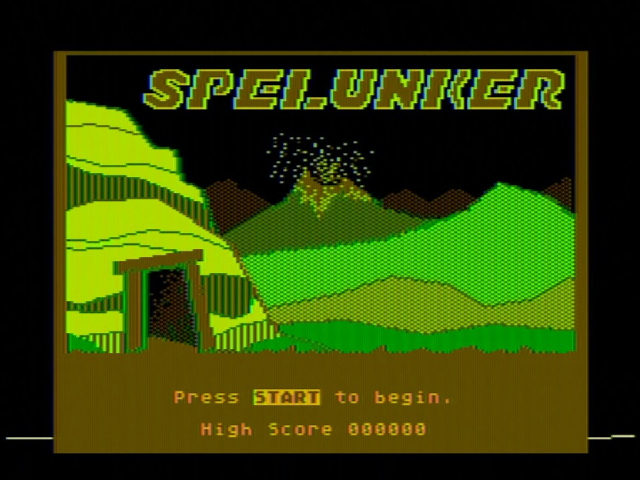
And thus Spelunker was released some time in 1983, before Pitfall II. I’ll be playing it on my Atari 130XE, but it was originally released as a disc game requiring 48kiB. That was the most RAM you could get in an Atari 400 or 800, which in 1983 were the most common models, though the 64kiB 1200XL was on the market, it was also flopping.
Diving down

What stands out to my eyes about Spelunker is how dense it is. Much like Pitfall II, it has smooth vertical scrolling, and flip-screen horizontal scrolling. In fact, Spelunker only has two screens worth of horizontal. This game is all about vertical motion. But let’s take a look at Pitfall!.
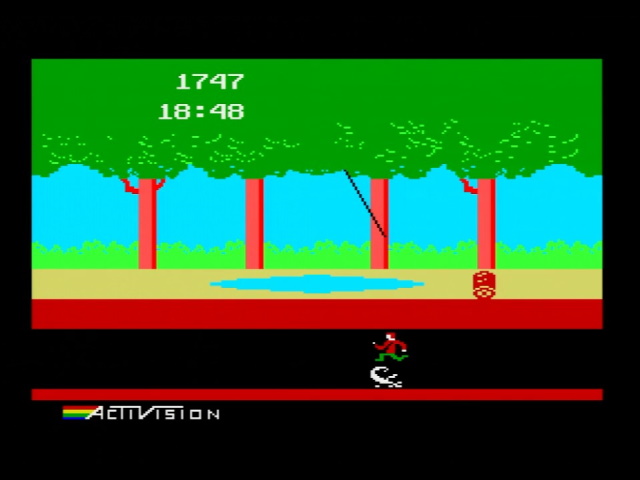
For the most part, side scrollers have used their larger world to space things out. Pitfall!, and Pitfall II doesn’t stray far in this regard, has basically one thing happening on each screen on each level. Here (on the MSX version) there’s a lake with a swinging vine and a few barrels on the top screen, and a scorpion on the bottom. But Spelunker meanwhile doesn’t do that at all– the screen is packed. The game may have come out before Pitfall II, but it’s arguably more sophisticated.

Spelunker really gives the impression of being lost in a giant maze of caves. It’s easy to lose your bearings. And our erstwhile spelunker (known to the developers as “the Dude”) has only a few tools at his disposal. He has a gun (which costs you energy to use), but it’s only useful to scare away ghosts, which appear randomly. (but more and more frequently, to the point that at the bottom, there is always a ghost on its way)

Every other tool you can get you’ll need to find, and are consumable. Two types of keys to open doors, dynamite to blow up obstructions (but get too close to your explosion and you’ll die), and flares that can scare away bats (but they’ll come back as soon as the flares come out).

Harsher is your energy, which is constantly draining, and can only be refilled at certain spots. You can also die from falling heights, but in 1982 that didn’t really feel unfair. Donkey Kong did it too, after all. In Spelunker, you can fall about two times your character’s height, which is pretty limiting, but at least in this version, it doesn’t feel unfair about it. It’s not like you die from jumping while going down a slope. That’d be ridiculous…
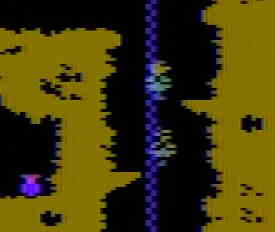
Like Pitfall II, Spelunker is a game best enjoyed through trial-and-error. The fragile Dude might be constantly dying, but it’s a home computer game, so you can always try again. The lives are limited, but respawning is generous, starting you at the last item you got. And even the game overs fit the theme; you’re a spelunker, getting deeper and deeper in the cave each time you try again.
The band of brothers
Unfortunately, Spelunker is a good game, but 1983 was a bad time to start a publishing house. MicroGraphicImage never seems to have failed, per se, but it did give up its most valuable possession, handing Spelunker over to established publisher Brøderbund.
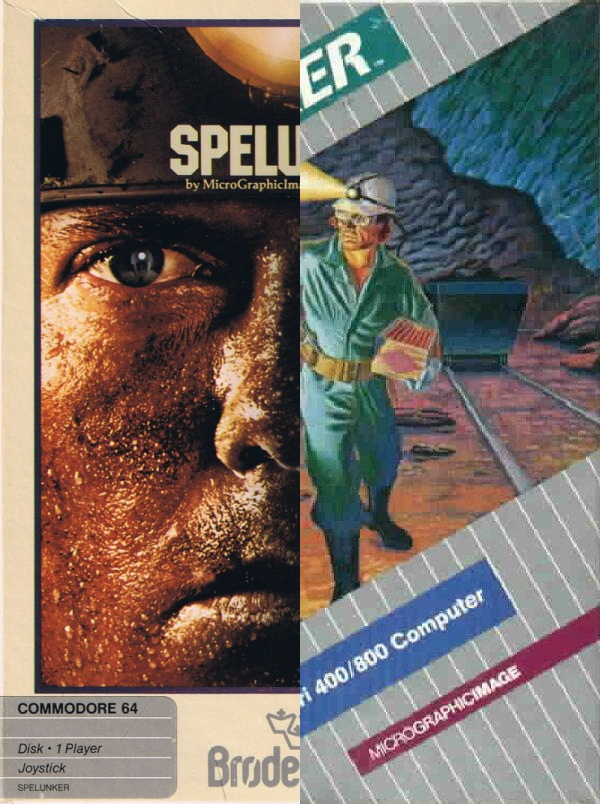
This doesn’t seem to have been acrimonious at all. In fact, MicroGraphicImage and developer Tim Martin, who has the credit for designing the game, continue to get credit. In fact, it was MicroGraphicImage who were commissioned to create the changes Brøderbund made in their release: not only did they add a port to the popular Commodore 64, they created a new intro, with music, replacing the static title screen I showed above. I love this title sequence; the cinematic opening credits and the dramatic music prepare you for the quest to come.
Overall, the Brøderbund era of Spelunker seems to have been a moderate success, but I’m not sure if it was a huge seller even with their marketing machine. After all, Spelunker never got ported beyond the Atari and Commodore machines; popular machines like the Apple ][ or the European computers (with an exception we’ll get to) didn’t get a port of this game. I’m not sure if it even left America in this form.
That being said, good Atari games didn’t always travel by being sold. And Spelunker definitely left its mark. Peter Finzel’s 1985 German release Cavelord, for example, shows clear Spelunker influence, along with a decidedly Joust bent on its controls.
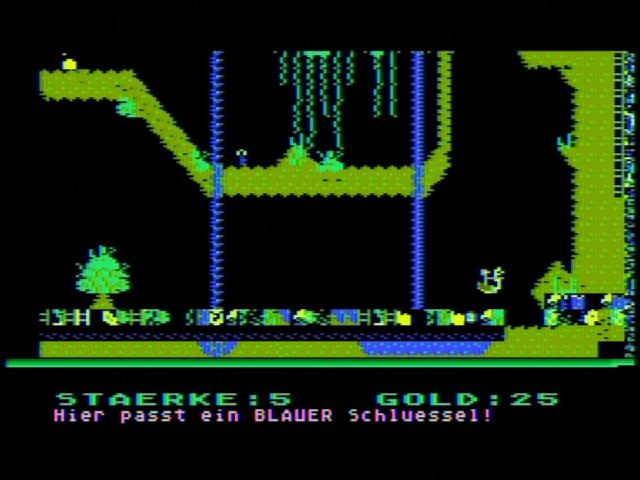
But fate, as it turns out, would have a greater plan for Spelunker. Because Brøderbund had friends in Japan.
I, rem
Irem (short for International Rental Electronics Machines) is one of the biggest names in early 80’s arcade machines, but I find that they get left behind in the west; they didn’t have an American arm, so had to license their games to others. Moon Patrol and MotoRace USA got credited to Williams; Kung Fu Master and Kid Niki: Radical Ninja to Data East; even their flagship R-Type got published by Nintendo.

And many of their best titles never left Japan. For example, their take on Brøderbund’s action-puzzle game Lode Runner was an arcade hit, notable enough that they kept pumping out further arcade Lode Runner games, making four in just two years between 1984 and 1986. But none of them seem to have ever left Japan.
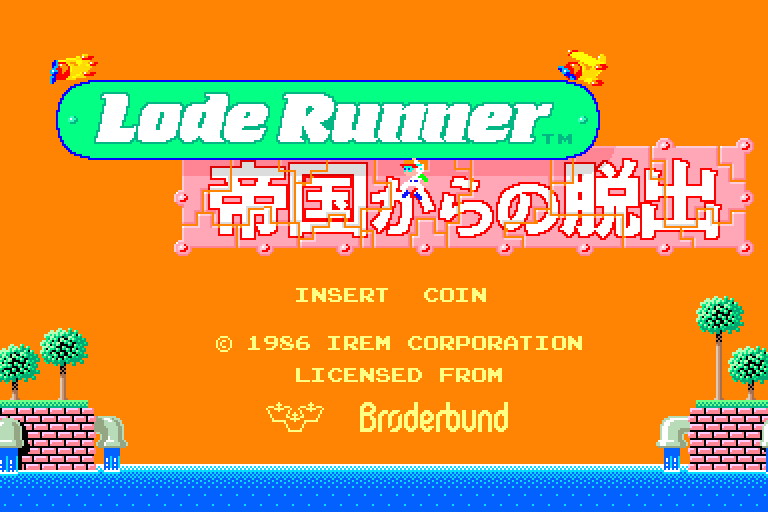
So it makes sense that they’d be interested in another puzzley-action game that Brøderbund had a license to; and they jumped on Spelunker.

Much like the arcade Lode Runner games, Spelunker runs on the Irem M-62 platform, a beefy stack of three boards, capable of feats like 12-bit RGB color, 64 sprites, a 4MHz Z80 CPU, and dual YM2149F (equivalent to the AY-3-8910s used in the Mockingboard) synthesizers controlled by a 6803 CPU. Definitely a formidable foe for Sega’s contemporaneous System 1, which we’ve already looked deeply into in the blog; it even has a higher horizontal resolution, 384 pixels vs. 256.
But all that power is useless if the game behind it isn’t any good. How did Spelunker jump to the arcade?
Spelunker
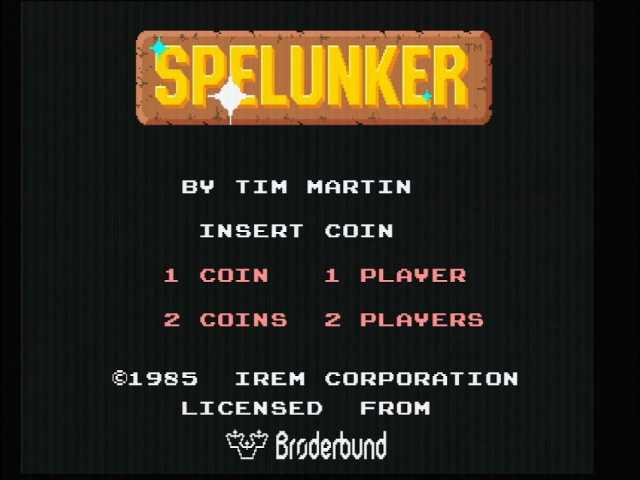
Spelunker may give Tim Martin and Brøderbund credit on the title screen, but as far as I know, neither had anything to do with this port beyond cashing some checks. The surprising thing about Spelunker is that in moving to arcades, the game had to get easier.

Everything’s got a makeover with the more advanced graphics; our Spelunker Dude in particular stands out as way more colorful. A Depth meter gives you real-time impression of your progress. Overall, this looks pretty similar. And on paper, Spelunker has the ingredients of a good arcade game:
- Ruthless in taking your lives; one-hit kills, fall damage, etc
- A strict level timer in the form of the energy meter
- A world large enough to be a challenge, but small enough that a skilled player could beat it in a short sitting
The problem is that the game was, to Irem, apparently a little too ruthless. Arcade Spelunker ditches the fall damage entirely, for example. You will be stunned after a brief fall (and thus very vulnerable to enemies), but it won’t kill you, no matter how high.

On the Atari and Commodore, your gun was very limited, being only useful to scare ghosts. On the arcade machines, it’s a flame thrower that can be used to kill enemies as well; the flares that scared away bats are removed, you can just burn them alive instead. The ghosts no longer show up semi-randomly, but at fixed points– these points aren’t marked, however, so it might feel that way unless you pay attention.

Overall all the major hits of the Atari version are here; the checkpoints in the Atari version still exist, and while the game map is redesigned, it hits a lot of the same beats. But with Spelunker Dude’s additional powers, even the addition of more powerful enemies like the minotaur-like guys that take multiple shots with your gun to kill don’t make the game feel as hopeless or vast. It’s not a bad game; it just doesn’t feel as unique as the Atari version.
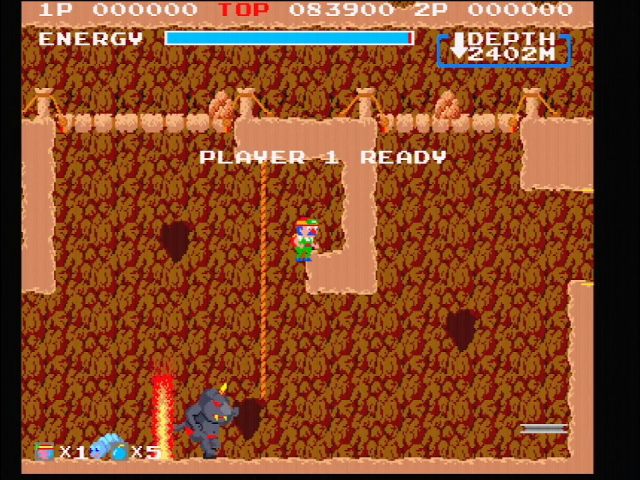
As an arcade game that encourages quarter-feeding, Spelunker allows unlimited continues as long as you pay up. And even dying quite a bit, it can be completed in less than an hour; and it definitely offers enough content to enjoy that playthrough. It was listed as the fourth most successful game of February 1986, so it had some staying power. It’s a lot friendlier of a game than Pitfall II, even as its source was much harsher than that game’s source; fascinating.
Bringing it home
With Lode Runner, Brøderbund had (initially) sold the rights to home consoles in Japan separately from the arcade rights; Irem made its arcade games, while Hudson Soft handled the port to the Nintendo Family Computer, a popular game console in Japan that had no US presence. And Lode Runner’s home port was a hit in Japan; Famicom gamers took to it as strongly as Apple ][ gamers did, but there were a lot more of them. Brøderbund would go on to brag about those mega-sales on their boxes.

For Spelunker, it seems like Irem wanted those sales for itself. (And even with Lode Runner, Irem would take over console games with the 1987 Super Lode Runner on the Family Computer Disk System) But in 1985, Irem was still dipping its toes into the home console industry. And so like Pony Canyon, they partnered with a contract developer– TOSE. TOSE have worked on a huge number of games, and they’re still around; but they’ve remained a contract developer and are rarely credited.
Spelunker on Famicom came out in Japan in 1985. Remember all those mappers I talked about in a prior post? Forget about them. Spelunker is an “NROM” game; that means 32kiB of program ROM, and 8kiB of CHR-ROM. And consider yourself lucky Irem was willing to spring for 32kiB.
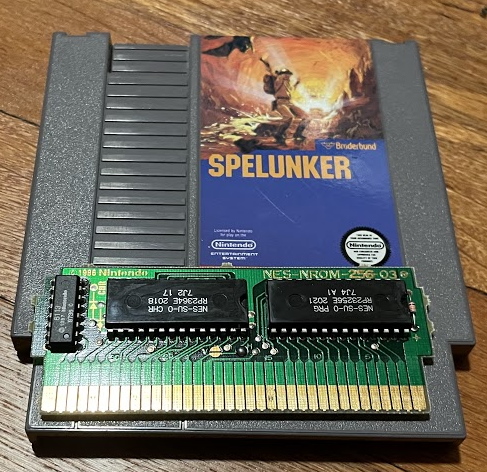
So this leads to an issue. Spelunker for Atari 400/800 required 48kiB of RAM; it loads additional data over the course of the game. (It shipped on a 90kiB disk) So sacrifices had to be made here; while the arcade version presented an expansion, on the meager Famicom, you can’t even expect to match the original. (Well, the graphics chips are different enough that it’s hard to be certain of that) So it’s not surprising that they decided to basically ignore all the changes the arcade version made.
So what is the NES version?
The Famicom’s colorful backgrounds and sprites definitely give this version a visual upgrade. However, I do think the new status bar, which is made entirely of sprites, is a bit harder to parse at a glance, especially with rocks in front of it. (Speaking of sprites, the game also doesn’t implement any sort of flicker, so if you have too many sprites per scanline, sprites remaining just drop out) Ghosts and your gun work the same way as on the Atari 400/800; no fireballs here.
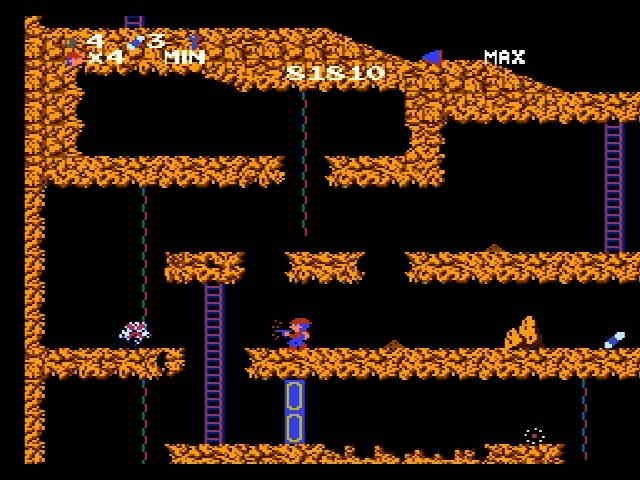
Compared to the Atari 400/800 version, the world is shrunk to almost a “greatest hits” version. The major beats are here, like the elevators, ropes, and the pyramid; but everything’s a bit simplified and shorter. The additional elements from the arcade version, like the giant monsters, are not here.
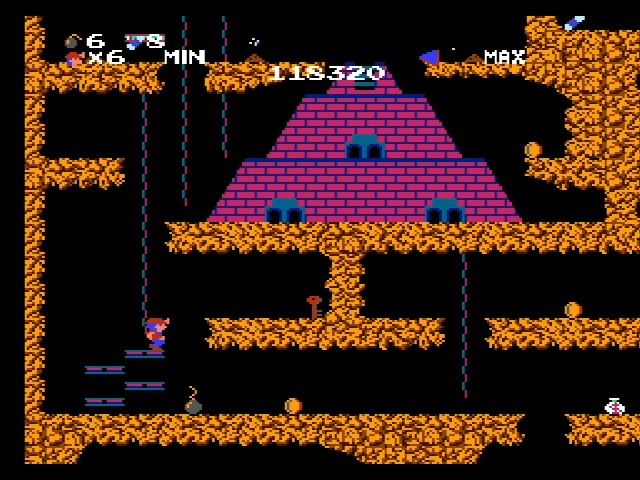
Perhaps most infamously, not only is there still fall damage– a lot less forgiveable in the post Super Mario Bros. era (though that era had barely begun, so maybe a little forgiveable)– it’s now a lot more restrictive too; less than your character’s height. You can jump down ramps and die in the process; pretty much everyone will die from fall damage on their first playthrough in a way that seems unfair.
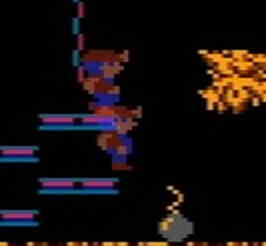
It’s jumping off ropes and ladders where this really gets messy. To jump off a rope, you must press the jump button and the directional arrow at exactly (or near-exactly) the same time. If the jump doesn’t trigger, the directional arrow will make you walk right off the rope, in which case the fall damage will definitely kill you. The best solution I came up with this is to use a turbo button controller to press the jump button. It may be cheating, but at least it makes this survivable.

Combining all those elements certainly makes Spelunker on Famicom a far more frustrating game. But in a way, isn’t it… funny? Consider this footage of what a new player to Spelunker might go through on their first playthrough:
The dramatic opening music, taken from the Brøderbund PC editions, is still present. But in the gameplay, you get a bright and cheery, much more typical “Famicom” theme. Well, for a few seconds– jumping higher off the elevator leads to your death. Trying to walk from the elevator to adjacent ground, a perfectly safe move on PC– it kills you. And while the world is tiny and dense, your lower jump height means even small drops kill you. A game over– before you’ve made enough progress to get annoyed by it.
Spelunker on Famicom is something almost magical in how it comes together. Had they nailed all the gameplay elements, it’d just be an inferior port of the PC game. Instead, it combines just enough Famicom polish (the colorful sprites, the peppy music) and harsh enough gameplay that it becomes a bad game of that special quality– a bad game that’s fun to play. It’s often seen as an orginator of what in Japan became known as “kusoge” fandom. (kusoge means, quite literally, “shit game”) And it’s short enough that with any luck, by the time the novelty wears off you’ve made it through a loop.

The game does loop after you beat it; the new world has a new palette, but the map is exactly the same. The only changes are different requirements for collecting keys, which seem to be an attempt to jump on the Tower of Druaga-esque opaque struggle. One loop, where you have to jump in the location of where keys are, definitely makes one think of the later Super Pitfall; in general, since the key locations are always the same as the first loop, here it’s just a memory puzzle and doesn’t add much. I have to wonder if that many players, even in 1985, even with nothing else to play bothered.
It comes home to you too, MSX gamers
I mentioned above that European computers didn’t get Spelunker. Well, the MSX computer isn’t European, but it was popular in Europe, so close enough. This came out in Japan in 1986 on cartridges, but also seems to have existed in Italy and Brazil on cassette, possibly unlicensed.
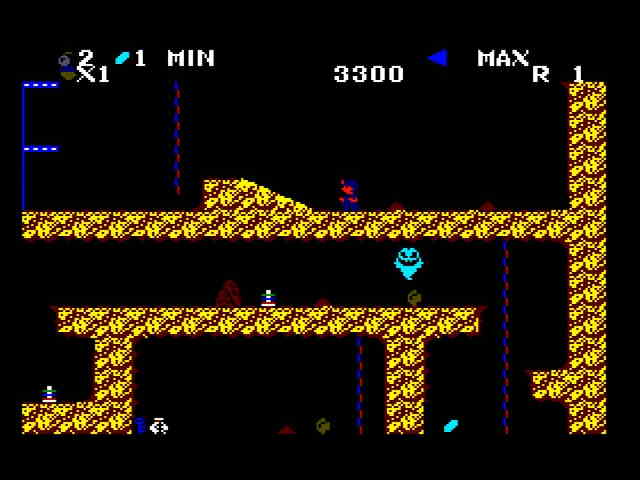
Spelunker on MSX is basically the same as the NES version, but the graphics are a little worse; not only is it on the more limited MSX1 platform, it brings down the size of the game to 32kiB. Honestly, putting this and the Famicom version side by side would be a pretty good advertisement for the Famicom.
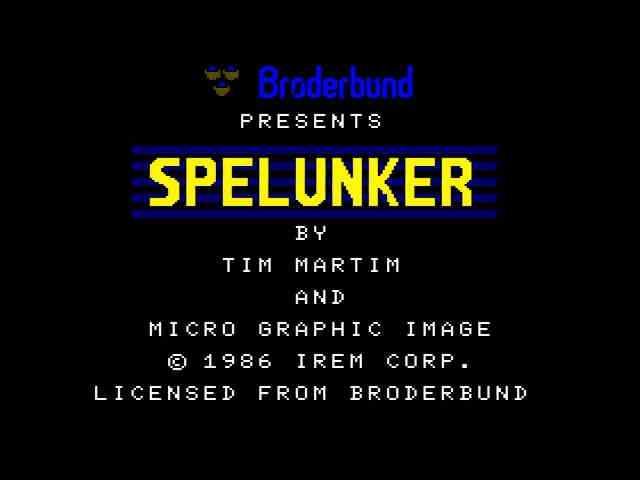
The other thing worth noting is that if you needed any proof that Tim Martin had nothing to do with the game by this point, they didn’t even bother to spell his name right on the title screen.
Timing, Timing, Timing… and glowing lights
Spelunker for Famicom came out at the end of 1985. It was a pretty good time to be a Famicom game where you jump around in a scrolling world; Super Mario Bros. was a hit. When Brøderbund got around to releasing it in September of 1987, they were able to brag about its Japanese sales as well. Of course it wasn’t as big as Lode Runner, but what was?
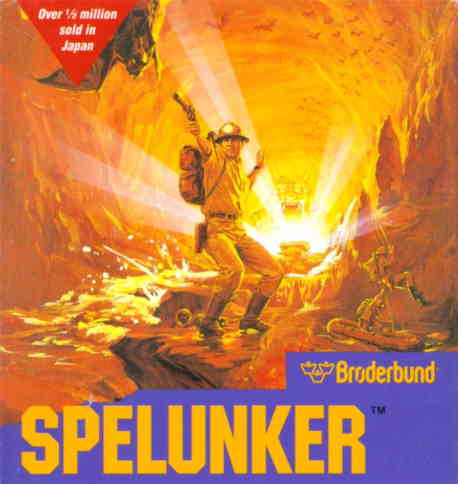
Ah yes, September of 1987. That would be a bit of a problem for our little friend. In Japan, Spelunker’s 1985 release date came right on the heels of Super Mario Bros. A tough-as-nails platformer based around exploration was a pretty new thing. In America, Spelunker had to compete on shelves with Metroid, which did exploration better, and came out nearly a year after Capcom’s Ghosts ‘n’ Goblins, which did the tough-as-nails better. Both those games benefitted from not only better design, but more advanced in-cartridge hardware. Spelunker looked pretty dated when it came out in the west, because it was pretty dated.
Speaking of looking, the Famicom version had another leg up on the NES there.

Now, as a child of the 1990’s I tend to associate Brøderbund’s blue trade dress with edutainment and tools like The Print Shop, but that reputation hadn’t been solidified by this point. What really makes the Famicom version stand out, though, is the LED on top. Apparently, Irem did have Nintendo manufacture their Famicom cartridges, but were able to get this special design as part of a deal that allowed Nintendo to fully handle Irem’s Spartan X console port. (Which came to the United States as Kung Fu)
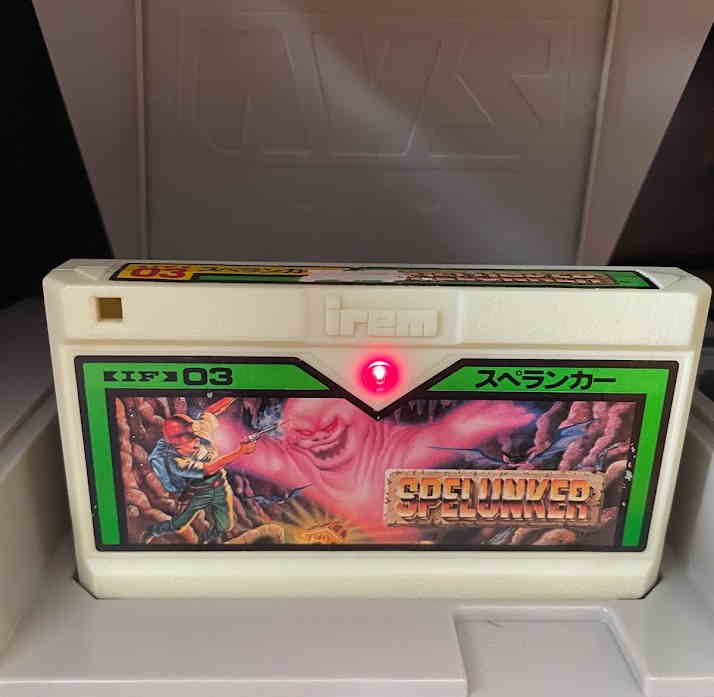
Now, this LED was on all of Irem’s early releases– Zippy Race, 10-Yard Fight, etc. But I have to expect that in a bin of used Famicom games, it probably helped Spelunker stand out, and make buyers a little more willing to give it a chance. With used game sales, 1/2 million new cartridges sold means a lot more people than that played it.
In any case, all this added up to: in the West, the NES release of Spelunker wasn’t that big of a deal. It’s a hard and frustrating NES game, sure, but not even popular American hard and frustrating NES game connoisseur “The Angry Video Game Nerd” has bothered to rant about it. In Japan, though? That’s another story. If you want a western equivalent, early western NES release Ghosts ‘n’ Goblins is probably the closest thing; but it came out months after Spelunker in Japan.
But first, the sequels
Both of Irem’s takes on Spelunker got sequels that don’t seem to have officially left Japan. Let’s talk about the arcade one first.
Spelunker II: 23 no Kagi
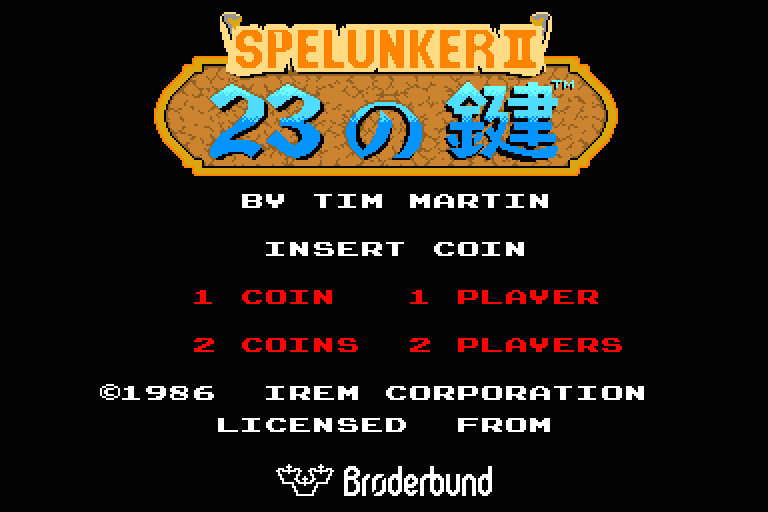
Spelunker II: 23 no Kagi, or the 23 keys, is only a minor push on the Spelunker arcade formula. All the same elements are here, alongside some new ones, like swimming and skateboarding. I don’t have a board for this one, but it seems to run fairly well in MAME.
However, one thing I do want to point out is a review of this arcade game from British magazine Computer+Video Games, preserved by solvalou.com. I’ve included the text of the article in the alt-text if you can’t read the image.

Our good reviewer Clare Edgeley did not enjoy Spelunker II, getting stuck immediately in the wall. Though my first question is how she played it. Was she in Japan? Or did some enterprising arcade operator ship a board or two out to the UK? I guess we may never know.
What we can tell is that Clare got immediately trapped in a cave-in when starting, and restarting and continuing still had no help. Guess what? I was able to do the same thing!
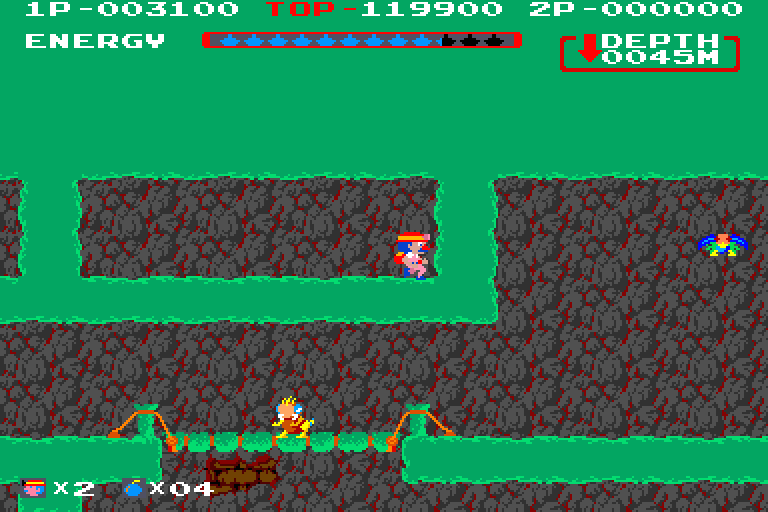
Now, the secret of this room is that there was a bomb in it. (That’s why you respawn– you respawn at the point of the last item you collected) If you then detonate the bomb in the right spot, then a rope will appear. If you use up all your bombs (you do start with a supply) then you are just as screwed as Clare described– at least until you continue, at which case you get more bombs.
In general I can’t help but blame my favorite 80’s video game villain: The Tower of Druaga. Read my Pitfall II article for my theory about how that game’s opaque design convinced Japanese arcade and console game developers that not revealing anything necessary to proceed makes your game better.
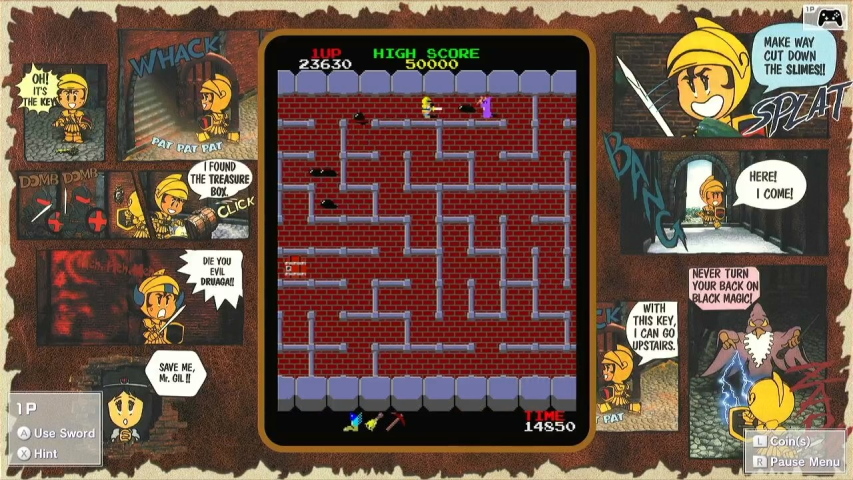
(Both Irem versions of the first Spelunker do have hidden items, but they are never necessary to beat the game) Spelunker II, unfortunately, is no Tower of Druaga. It would be the last Spelunker arcade game.
Spelunker II: Yuusha e no Chousen
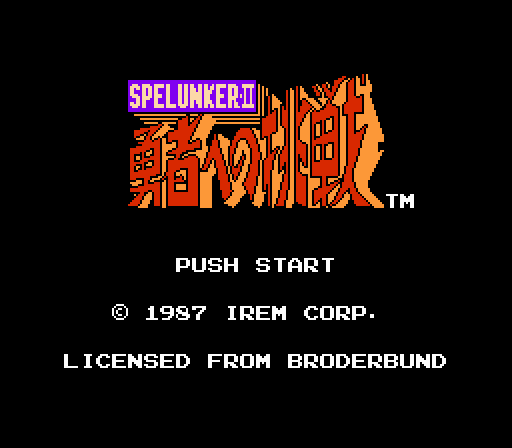
The Famicom version of Spelunker II, released at the same time as the Famicom release of the first game in September 1987, has nothing to do with the Spelunker II in arcades, and honestly, noi much to do with the first Spelunker either, though you can play as a spelunker, among several selectable characters.
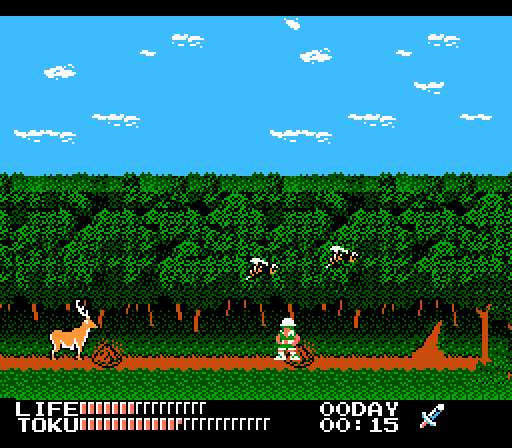
It’s an open world action-platformer with RPG elements, a very popular genre at the time. It also has a virtue system; you want to kill evil enemies and not good enemies, or you’ll get different endings. Overall the game makes me wonder if Irem just decided to use the Spelunker name for an otherwise unrelated game in an attempt to increase sales.
Legacy of the Spelunker
Around 2254 BC, Naram-Sin, grandson of the famous Sargon, acceded to the throne of the Akkadian Empire. He was said in Akkadian records to have angered the gods; later generations blamed him for the downfall of Akkad, though its fall did not take place in his lifetime. Generations later, it’s theorized that the Hebrews may have wrote of Naram-Sin when they spoke of an ancient king they called Nimrod, who in later tradition is said to have ordered the building of the famous Tower of Babel. This angered the one God the Hebrews worshipped, and resulted in Spelunker II: Yuusha e no Chousen not being in the same language as this blog post, which is overall rather inconvenient.
In the Hebrews’ account, preserved in what is now often called the Book of Genesis, Nimrod is referred to not only as a great king, but as a mighty hunter. And with the popularity of the Genesis account in later religions, Nimrod entered somewhat common parlance as an epithet for calling someone a great hunter; or perhaps, an ironic way of calling someone a not-so-great hunter, as Daffy Duck referred to the hapless Elmer Fudd as a “poor little Nimrod” in a 1940’s cartoon. And that settled it– the popularity of the Warner Bros. cartoons was such that the great king’s name took on an entirely new meaning. Very few English-speakers in 2022 would consider being called a ‘nimrod’ a compliment.
Well, in Japanese, you may not want to be called a spelunker.

The comparison to Nimrod may be overstated in its degree of cultural ubiquity. But do a quick search on YouTube for “スペランカー 野球” (superankaa yakyuu, or ‘spelunker baseball’) and you’ll find quite a few videos talking about how some baseball players are known as “spelunkers”, or having a “spelunker’s constitution” (スペ体質, supe-taishitsu). That’s not a reference to the strength or night-vision required to explore caves. It’s a reference to our death-prone dude, known in Japan as the weakest hero in the history of video games. Saying a player has a spelunker’s constitution is a way of poking fun at a them for getting injured a bit too often for the fans’ liking.
Who’s the Spelunker now?
Now, the popularity of the Famicom in Japan, the perfect timing of Spelunker to capitalize on Super Mario Bros., and its hilariously cruel approach to difficulty probably all played a major role in Spelunker’s success. But let’s not discount Irem deliberately wanting to do so. In the late 1990’s, Irem issued on its website a series of 4koma (4-panel comics) entitled “Spelunker-sensei”, in which the famed Spelunker has gained a new career, without hanging up his hard hat.
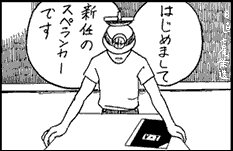
It goes without saying by this point– Spelunker dude dies. A lot.
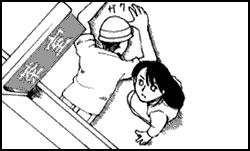
The comic features a number of Irem characters, but Spelunker in particular seems to be a popular character. (And he is now an Irem character; they seem to have acquired Brøderbund’s rights some time in the 1990’s) This led to his own 30-minute OVA, Spelunker-sensei: Spelunker is a Teacher, which is mostly worth watching for its excellent English opening song; whether anything else there is worth seeing is up for debate.

It wasn’t just Irem, though. For example, in February 2007, the Japanese indie game Shobon no Action, also known as “Cat Mario” in the west, was released on the internet forum 2channel. A famous spoof of platforming, it was very influential even on western games like I Wanna Be the Guy, its combination of difficult gameplay and downright mean traps, it would bring on a whole host of “masocore” games designed specifically to torment players. And what does this have to do with Spelunker?
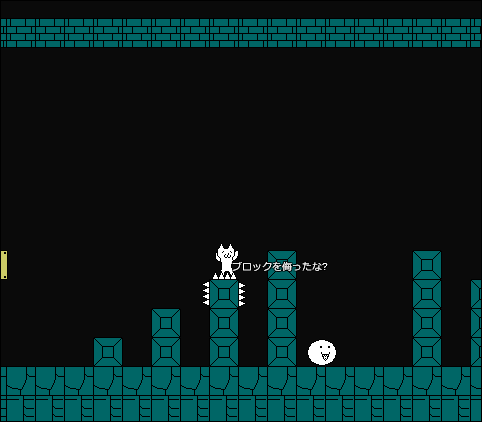
The music of the underground stage, which imitates Super Mario Bros.’s 1-2, is a remix of Spelunker’s NES gameplay music. Given the earlier above-ground stage music was from Cheetahmen 2, an unreleased sequel to Action 52, it’s perhaps not quite a compliment to Spelunker, but it’s definitely a statement of some sort about the influence Spelunker has had.
For more about the cultural impact of Spelunker, I’d check out the Bad Game Hall of Fame article on the game.
Games are back
Isn’t this is a video game blog post? Well, in 2009, Irem and partner Tozai Games would release the first new Spelunker game since 1987’s Spelunker II: Spelunker HD. (Or, in Japan, Minna de Spelunker, “Everybody’s Spelunker”) What I have here, though, is Spelunker HD Deluxe, which was nice enough to receive a US release boxed for the Nintendo Switch.

So what is Spelunker HD? It’s definitely a nostalgia game. (Tim Martin even gets a shoutout on the title screen! What’s he been up to since? Well, uh, apparently he discovered free energy. So that’s nice) Again, I’m playing the remake, not the original, so be careful to compare– I don’t have a PlayStation 3.
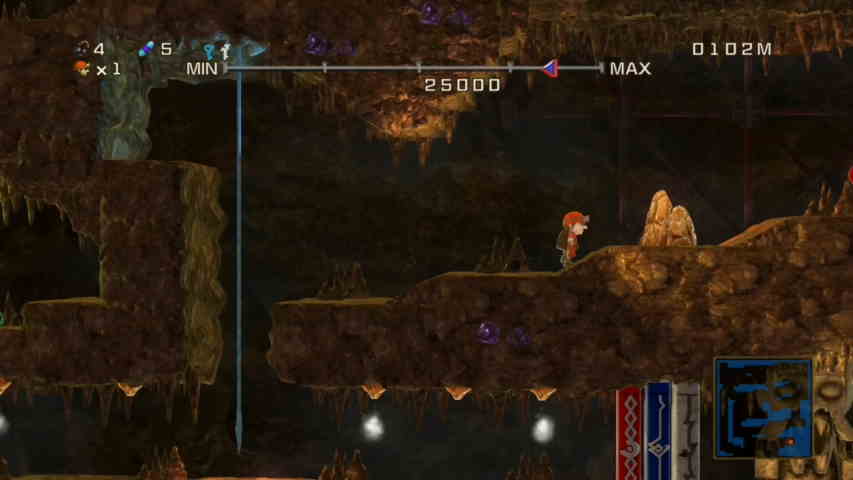
Spelunker HD is divided into a number of stages. Each of these stages ends the same way as a section of the caves in Spelunker, but they’re somewhat shorter and punchier feeling. The same basic elements of the NES port of Spelunker are present– the short distance fall death, the locks and keys, but the rope jumping has been made a bit easier to deal with.
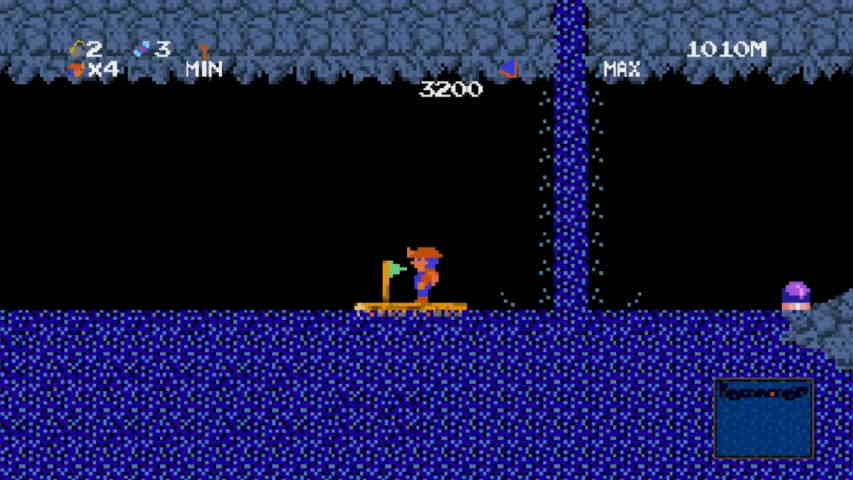
You have the option of playing the game in an “HD” style with 3D graphics, or in the classic NES style. (Which gives you less screen space than the NES, amusingly) Sadly, there are no options for the Atari 400/800 style or the arcade. However, one little bit of the arcade does show up here: the meter counter that goes down the further you get into the game.
Every ten stages, you reach a checkpoint stage (called a new area) that means you can continue from that point, and the music and graphics change; otherwise, you’re limited by lives. This means that it continues the classic Spelunker concept of getting further and further down on each run. It even gives you a nice little post-death message. (And apparently can rank your progress on a leaderboard, but I don’t have Switch Online)
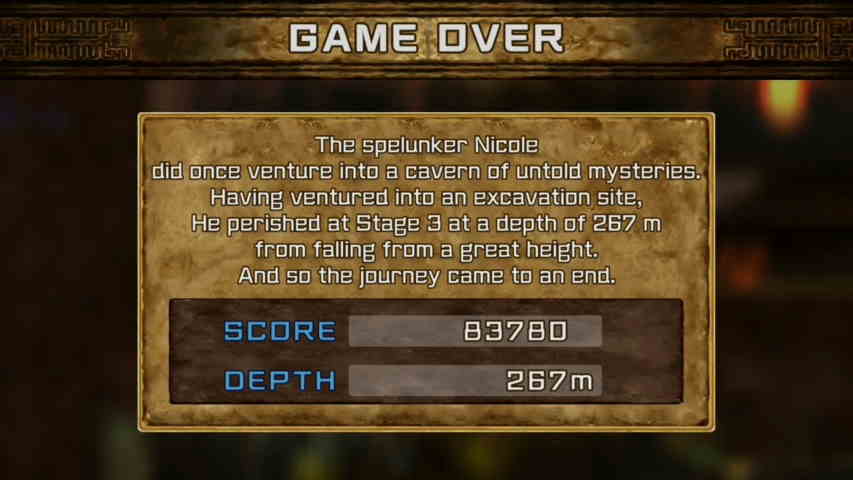
Irem released a follow-up called Spelunker Black in 2010; it is identical in gameplay, with the addition that you only have a small visible area on the screen. The game’s flares, otherwise only useful to scare bats, gain an additional use here.
Unfortunately, in 2011 the northern portion of Japan was struck by a devastating 9.0 magnitude earthquake and tsunami. As a result of the destruction and its consequences for Japan’s economy and industry, Irem exited the video game industry to focus on pachinko.
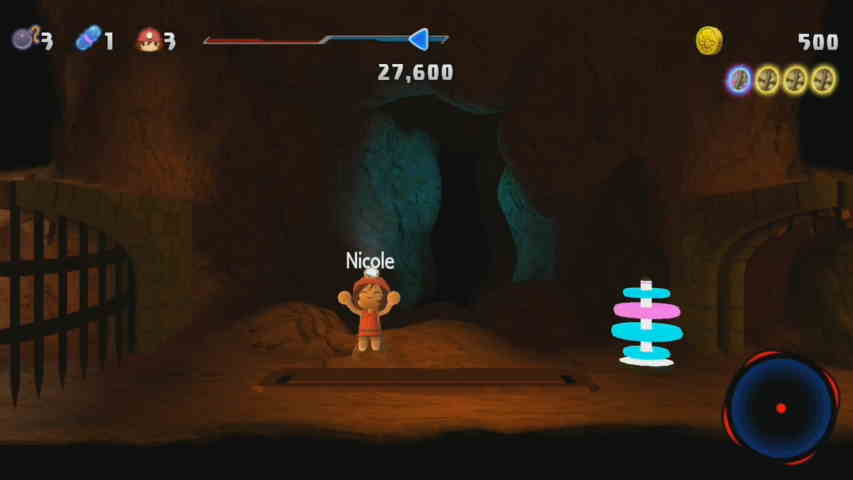
And Spelunker was sold to Tozai Games, who also seem to have the rights to Lode Runner and in general seem to be bringing the Irem game back together. This included the now discontinued free-to-play Spelunker World (bringing its arcade-era unfairness mindset to the gacha era), and its not free to play console port, Minna no Waiwai Spelunker (“Everybody’s Party Spelunker”), or Spelunker Party in the west. And now with Spelunker HD Deluxe, they seem really committed to the series.
You might say that they just keep digging themselves deeper.

